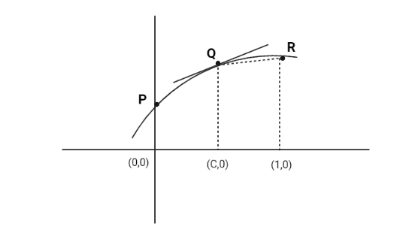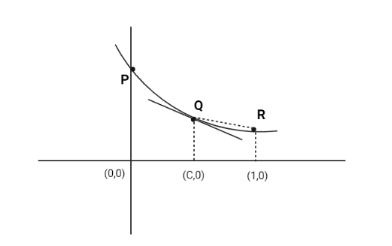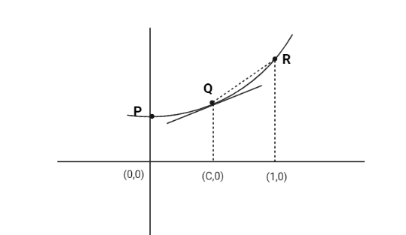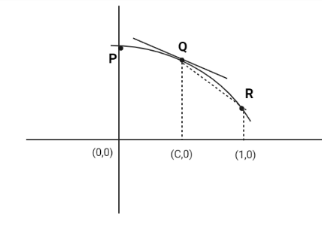
Let $ S $ be the set of all functions $ f:[0,1] \to R $ , which are continuous on $ [0,1] $ and differentiable on $ (0,1). $ Then for every $ f $ in $ S $ , there exists a $ c \in (0,1) $ , depending on $ f $ , such that:
$
1.\left| {f(c) - f(1)} \right| < (1 - c)\left| {f'(c)} \right| \\
2.\dfrac{{f(1) - f(c)}}{{1 - c}} = f'(c) \\
3.\left| {f(c) + f(1)} \right| < (1 + c)\left| {f'(c)} \right| \\
4.\left| {f(c) - f(1)} \right| < \left| {f'(c)} \right| \\
$
Answer
513k+ views
Hint: We will use Lagrange’s mean value theorem which states that if a function is differentiable on (0,1) and continuous on [0,1]. Then, there exists a c such that
$ f'(c) = \dfrac{{f(1) - f(c)}}{{1 - c}} $ where $ c \in (0,1) $ .
Now, using this theorem we will construct graphs and then interpret the values.
Complete step by step solution:
Case 1:
In the below image we see that,
$ f'(c) > $ slope of $ QR $
Now, we know that slope of QR is $ \dfrac{{f(1) - f(c)}}{{1 - c}} $
Hence, $ f'(c) > \dfrac{{f(1) - f(c)}}{{1 - c}} $
$ \therefore (1 - c)\left| {f'(c)} \right| > \left| {f(c) - f(1)} \right| $

Now, In the below figure we see that the slope of $ f'(c) $ and slope of QR is negative. But, the slope of $ f'(c) $ is more negative than the slope of QR.

$ \left| {f'(c)} \right| > $ | slope of QR|
we know that slope of QR is $ \dfrac{{f(1) - f(c)}}{{1 - c}} $
$ \therefore (1 - c)\left| {f'(c)} \right| > \left| {f(c) - f(1)} \right| $
From the above two graphs we conclude that
$ (1 - c)\left| {f'(c)} \right| > \left| {f(c) - f(1)} \right| $
Case 2:
In the below image we see that,

$ f'(c) < $ slope of $ QR $
Now, we know that slope of QR is $ \dfrac{{f(1) - f(c)}}{{1 - c}} $
Hence, $ f'(c) < \dfrac{{f(1) - f(c)}}{{1 - c}} $
$ \therefore (1 - c)\left| {f'(c)} \right| < \left| {f(c) - f(1)} \right| $
Now, In the below figure we see that the slope of $ f'(c) $ and slope of QR is negative. But, the slope of $ f'(c) $ is less negative than the slope of QR.

$ \left| {f'(c)} \right| < $ | slope of QR|
we know that slope of QR is $ \dfrac{{f(1) - f(c)}}{{1 - c}} $
$ \therefore (1 - c)\left| {f'(c)} \right| < \left| {f(c) - f(1)} \right| $
From the above two graphs we conclude that
$ (1 - c)\left| {f'(c)} \right| < \left| {f(c) - f(1)} \right| $
Now, from all the available options we see that option 1 matches with case 2.
Hence the correct option is 1.
So, the correct answer is “Option 1”.
Note: In the proof of the Fundamental Theorem of Calculus, the Mean Value Theorem plays a significant part. If f exists and is bounded on the interior and is continuous on $ [a,b] $ , then f is of Bounded Variation on $ [a,b] $ .
$ f'(c) = \dfrac{{f(1) - f(c)}}{{1 - c}} $ where $ c \in (0,1) $ .
Now, using this theorem we will construct graphs and then interpret the values.
Complete step by step solution:
Case 1:
In the below image we see that,
$ f'(c) > $ slope of $ QR $
Now, we know that slope of QR is $ \dfrac{{f(1) - f(c)}}{{1 - c}} $
Hence, $ f'(c) > \dfrac{{f(1) - f(c)}}{{1 - c}} $
$ \therefore (1 - c)\left| {f'(c)} \right| > \left| {f(c) - f(1)} \right| $

Now, In the below figure we see that the slope of $ f'(c) $ and slope of QR is negative. But, the slope of $ f'(c) $ is more negative than the slope of QR.

$ \left| {f'(c)} \right| > $ | slope of QR|
we know that slope of QR is $ \dfrac{{f(1) - f(c)}}{{1 - c}} $
$ \therefore (1 - c)\left| {f'(c)} \right| > \left| {f(c) - f(1)} \right| $
From the above two graphs we conclude that
$ (1 - c)\left| {f'(c)} \right| > \left| {f(c) - f(1)} \right| $
Case 2:
In the below image we see that,

$ f'(c) < $ slope of $ QR $
Now, we know that slope of QR is $ \dfrac{{f(1) - f(c)}}{{1 - c}} $
Hence, $ f'(c) < \dfrac{{f(1) - f(c)}}{{1 - c}} $
$ \therefore (1 - c)\left| {f'(c)} \right| < \left| {f(c) - f(1)} \right| $
Now, In the below figure we see that the slope of $ f'(c) $ and slope of QR is negative. But, the slope of $ f'(c) $ is less negative than the slope of QR.

$ \left| {f'(c)} \right| < $ | slope of QR|
we know that slope of QR is $ \dfrac{{f(1) - f(c)}}{{1 - c}} $
$ \therefore (1 - c)\left| {f'(c)} \right| < \left| {f(c) - f(1)} \right| $
From the above two graphs we conclude that
$ (1 - c)\left| {f'(c)} \right| < \left| {f(c) - f(1)} \right| $
Now, from all the available options we see that option 1 matches with case 2.
Hence the correct option is 1.
So, the correct answer is “Option 1”.
Note: In the proof of the Fundamental Theorem of Calculus, the Mean Value Theorem plays a significant part. If f exists and is bounded on the interior and is continuous on $ [a,b] $ , then f is of Bounded Variation on $ [a,b] $ .
Recently Updated Pages
Master Class 12 Business Studies: Engaging Questions & Answers for Success

Master Class 12 Economics: Engaging Questions & Answers for Success

Master Class 12 English: Engaging Questions & Answers for Success

Master Class 12 Maths: Engaging Questions & Answers for Success

Master Class 12 Social Science: Engaging Questions & Answers for Success

Master Class 12 Chemistry: Engaging Questions & Answers for Success

Trending doubts
What is meant by exothermic and endothermic reactions class 11 chemistry CBSE

Which animal has three hearts class 11 biology CBSE

10 examples of friction in our daily life

One Metric ton is equal to kg A 10000 B 1000 C 100 class 11 physics CBSE

1 Quintal is equal to a 110 kg b 10 kg c 100kg d 1000 class 11 physics CBSE

Difference Between Prokaryotic Cells and Eukaryotic Cells




